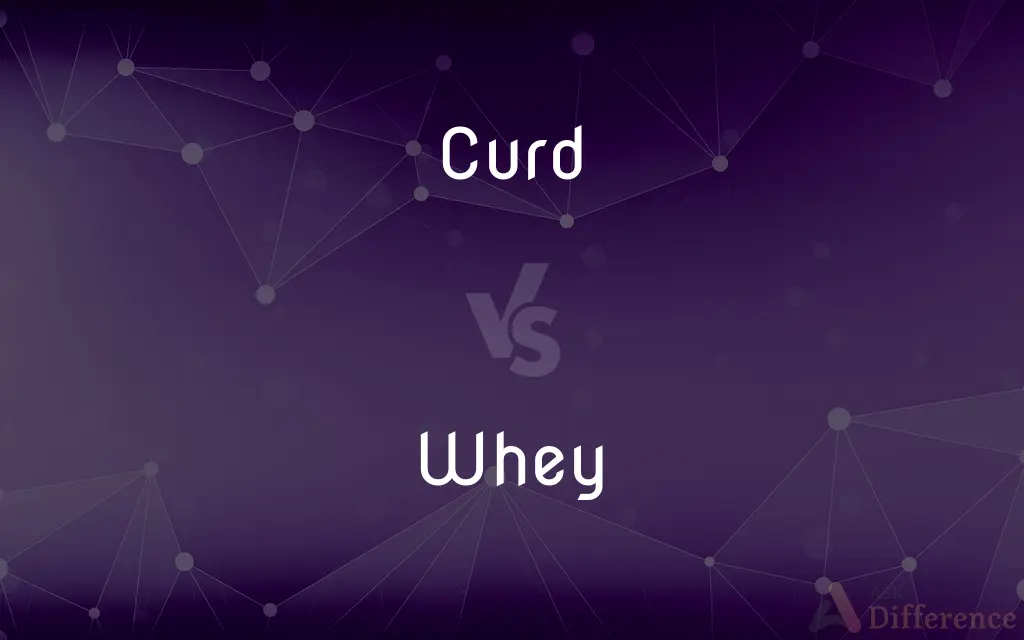Curd vs. Whey — What's the Difference?
Edited by Tayyaba Rehman — By Fiza Rafique — Updated on May 9, 2024
Curd is a dairy product obtained by coagulating milk, offering a thick, creamy texture and mild flavor, whereas whey is the liquid byproduct from curd production, known for its high protein content and watery consistency.

Difference Between Curd and Whey
Table of Contents
ADVERTISEMENT
Key Differences
Curd is formed by the coagulation of milk proteins like casein when acidic substances are introduced, creating a solid mass that is rich in fat and protein. Whereas whey is the liquid that separates from the curd during the coagulation process, containing proteins such as albumin and globulins, which are highly valued in various dietary supplements.
Curd serves as an excellent source of calcium and probiotics, beneficial for bone health and digestion. On the other hand, whey is praised for its rapid absorption rate in the body, making it a favorite among athletes for muscle recovery and growth.
While curd is often used in cooking and as a standalone dish in various cultures, whey is typically processed into whey protein powders or used in the production of other dairy products like ricotta cheese.
Curd can be flavored with fruits and spices to enhance its taste, or used in sauces and dips, highlighting its versatility in culinary uses. Whey, however, is commonly added to smoothies, health shakes, or used in baking, providing a protein boost without altering the flavor significantly.
Comparison Chart
Composition
Coagulated milk proteins, mainly casein.
Liquid containing milk proteins like albumin.
ADVERTISEMENT
Texture
Thick, creamy.
Thin, watery.
Use in diet
Consumed directly, used in cooking.
Used in supplements, baking.
Nutritional Focus
High in calcium and probiotics.
High in quickly absorbed proteins.
Flavor
Mild, can be flavored with fruits or spices.
Neutral, does not impact flavor of dishes much.
Compare with Definitions
Curd
An excellent source of dairy-based probiotics.
Eating curd daily can improve your digestive health.
Whey
The watery part of milk that remains after the formation of curds.
Whey is often used in the production of ricotta cheese.
Curd
A soft, white substance formed when milk coagulates, often eaten as a dessert or used in cooking.
Curd is a staple in many vegetarian diets.
Whey
Utilized in various forms such as concentrates, isolates, and hydrolysates.
Whey isolate is a highly pure form of protein.
Curd
A thick and creamy food item, integral to various cuisines around the world.
Curd topped with honey is a delicious breakfast option.
Whey
A byproduct of cheese or casein and used in making supplements.
Whey protein is popular among bodybuilders.
Curd
Used in making cheese and other dairy products.
They drained the curd to make fresh cheese.
Whey
Known for its role in weight management and muscle repair.
He added whey powder to his morning smoothie for muscle growth.
Curd
A dairy product made by curdling milk with rennet or an edible acidic substance such as lemon juice or vinegar.
She made fresh curd at home using lemon juice.
Whey
Rich in lactose, vitamins, and minerals, beneficial for health.
Whey is added to baby formulas for extra nutrition.
Curd
Curd is obtained by coagulating milk in a sequential process called curdling. It can be a final dairy product or the first stage in cheesemaking.
Whey
Whey is the liquid remaining after milk has been curdled and strained. It is a byproduct of the manufacture of cheese or casein and has several commercial uses.
Curd
The part of milk that coagulates when the milk sours or is treated with enzymes. Curd is used to make cheese.
Whey
The watery part of milk that separates from the curds, as in the process of making cheese.
Curd
A lump of curd
Cheese curds.
Whey
The liquid remaining after milk has been curdled and strained in the process of making cheese.
Curd
A coagulated liquid that resembles milk curd.
Whey
The serum, or watery part, of milk, separated from the more thick or coagulable part, esp. in the process of making cheese.
Curd
To form or cause to form into curd; curdle.
Whey
The serum or watery part of milk that is separated from the curd in making cheese
Curd
The part of milk that coagulates when it sours or is treated with enzymes; used to make cottage cheese, dahi, etc.
Whey
Watery part of milk produced when raw milk sours and coagulates;
Little Miss Muffet sat on a tuffet eating some curds and whey
Curd
The coagulated part of any liquid.
Curd
The edible flower head of certain brassicaceous plants.
Curd
(intransitive) To form curd; to curdle.
Curd
(transitive) To cause to coagulate or thicken; to cause to congeal; to curdle.
Curd
The coagulated or thickened part of milk, as distinguished from the whey, or watery part. It is eaten as food, especially when made into cheese.
Curds and cream, the flower of country fare.
Curd
The coagulated part of any liquid.
Curd
The edible flower head of certain brassicaceous plants, as the broccoli and cauliflower.
Broccoli should be cut while the curd, as the flowering mass is termed, is entire.
Cauliflowers should be cut for use while the head, or curd, is still close and compact.
Curd
To cause to coagulate or thicken; to cause to congeal; to curdle.
Does it curd thy bloodTo say I am thy mother?
Curd
To become coagulated or thickened; to separate into curds and whey
Curd
A coagulated liquid resembling milk curd;
Bean curd
Lemon curd
Curd
Coagulated milk; used to made cheese;
Little Miss Muffet sat on a tuffet eating some curds and whey
Common Curiosities
Can curd help with weight loss?
Yes, curd can aid in weight loss by improving digestion and providing a feeling of fullness due to its protein and fat content.
How do curd and whey contribute to bone health?
Curd is excellent for bone health due to its high calcium content, whereas whey contributes less directly but still offers vital proteins and minerals.
Is curd or whey better for quick muscle recovery?
Whey is preferred for quick muscle recovery due to its rapid protein absorption rate.
What are some traditional dishes that use curd?
Traditional dishes such as Indian raita, Greek tzatziki, and Eastern European blintzes commonly use curd.
How does the protein content of curd compare to that of whey?
Whey generally has a higher protein content compared to curd, and the protein in whey is more rapidly absorbed by the body.
How do the textures of curd and whey differ?
Curd has a thick and creamy texture, while whey is thin and watery.
Are there vegan alternatives to curd and whey?
Yes, there are vegan alternatives like soy yogurt for curd and rice or pea protein isolates for whey.
What is the primary nutritional difference between curd and whey?
Curd is rich in calcium and probiotics, whereas whey contains high levels of fast-absorbing proteins.
Can whey be used in non-food products?
Yes, whey is used in various non-food products including cosmetics and pharmaceuticals, due to its nutritional properties.
What are the environmental impacts of producing curd versus whey?
The production of both curd and whey has environmental impacts, but whey production can be more sustainable if the byproduct is fully utilized in other products.
How should curd and whey be stored to maintain their freshness?
Curd should be stored in a refrigerator and consumed within a few days, while whey protein powder has a longer shelf life and should be kept in a cool, dry place.
How are curd and whey produced?
Curd is produced by adding an acid to milk, causing it to coagulate; whey is the liquid byproduct of this process.
Are curd and whey suitable for lactose-intolerant individuals?
Whey might be problematic for some lactose-intolerant individuals due to its higher lactose content, whereas curd's lactose is partially broken down.
Can both curd and whey be used in baking?
Yes, both can be used in baking; curd can add creaminess, while whey can improve protein content without altering flavor.
What are the uses of whey in the fitness industry?
Whey is extensively used in the fitness industry for muscle repair and as a dietary supplement.
Share Your Discovery

Previous Comparison
Bucatini vs. Linguine
Next Comparison
Reporter vs. PaparazziAuthor Spotlight
Written by
Fiza RafiqueFiza Rafique is a skilled content writer at AskDifference.com, where she meticulously refines and enhances written pieces. Drawing from her vast editorial expertise, Fiza ensures clarity, accuracy, and precision in every article. Passionate about language, she continually seeks to elevate the quality of content for readers worldwide.
Edited by
Tayyaba RehmanTayyaba Rehman is a distinguished writer, currently serving as a primary contributor to askdifference.com. As a researcher in semantics and etymology, Tayyaba's passion for the complexity of languages and their distinctions has found a perfect home on the platform. Tayyaba delves into the intricacies of language, distinguishing between commonly confused words and phrases, thereby providing clarity for readers worldwide.
















































